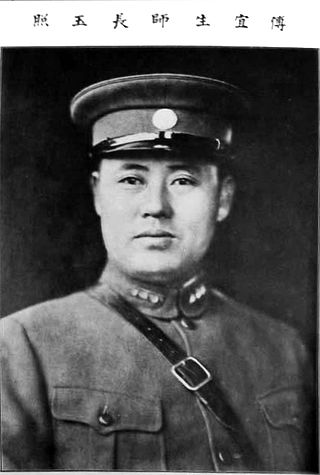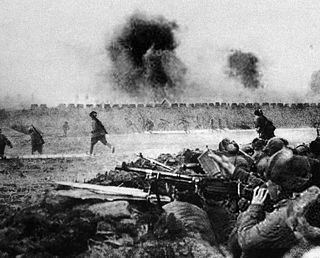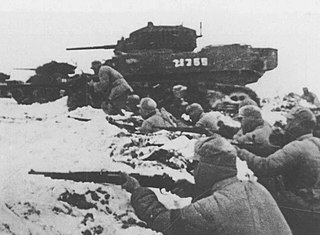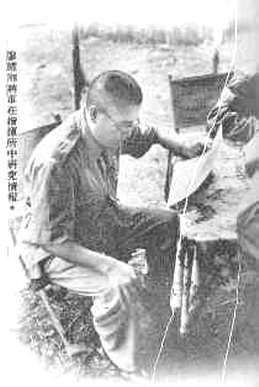
Chiang Kai-shek was a Chinese politician, revolutionary, and general who led the Republic of China (ROC) from 1928 until his death in 1975. His government was based in mainland China until it was defeated in the Chinese Civil War by the Chinese Communist Party (CCP) in 1949, after which he continued to lead the Republic of China on the island of Taiwan. Chiang served as the de facto leader of the Nationalist Kuomintang (KMT) party and the commander-in-chief of the National Revolutionary Army (NRA) from 1926 until his death, during which he was known as Generalissimo.

Zhou Enlai was a Chinese statesman, diplomat, and revolutionary who served as the inaugural premier of the People's Republic of China (PRC) from 1949 until his death in 1976, and concurrently as the inaugural Minister of Foreign Affairs from 1949 to 1958. Zhou was a key figure in the Chinese Communist Party (CCP) and ally of Mao Zedong during the Chinese Civil War, later helping consolidate its control, form its foreign policy, and develop the economy.

The Chinese Civil War was fought between the Kuomintang-led government of the Republic of China and the forces of the Chinese Communist Party (CCP), with armed conflict continuing intermittently from 1 August 1927 until Communist victory resulted in their total control over mainland China on 7 December 1949.

The Xi'an Incident was a major Chinese political crisis from 12 to 26 December 1936. Chiang Kai-shek, leader of the Nationalist government of China, was placed under house arrest in the city of Xi'an by a Nationalist army he was there to review. Chiang's captors hoped to end the Chinese Civil War and confront Japanese imperial expansion into Chinese territory. After two weeks of intense negotiations between Chiang, his captors, representatives of the Chinese Communist Party (CCP), and significant external pressure from Soviet leader Joseph Stalin, the two parties agreed to pursue a strategy of cooperation against future Japanese aggression.

Li Zongren, courtesy name Telin, was a prominent Chinese warlord based in Guangxi and Kuomintang (KMT) military commander during the Northern Expedition, Second Sino-Japanese War and Chinese Civil War. He served as vice-president and acting president of the Republic of China under the 1947 Constitution.

Du Yuming was a Kuomintang field commander. He was a graduate of the first class of Whampoa Academy, took part in Chiang's Northern Expedition, and was active in southern China and in the Burma theatre of the Sino-Japanese War. After the Japanese surrendered in 1945, he was an important commander in the Chinese Civil War.

Fu Zuoyi was a Chinese military leader. He began his military career in the service of Yan Xishan, and he was widely praised for his defense of Suiyuan from the Japanese. During the final stages of the Chinese Civil War, Fu surrendered the large and strategic garrison around Beiping to Communist forces. He later served in the government of the People's Republic of China as Minister of the Hydraulic Ministry.

The Liaoshen campaign, an abbreviation of Liaoning–Shenyang campaign after the province of Liaoning and its Yuan directly administered capital city Shenyang, was the first of the three major military campaigns launched by the Communist People's Liberation Army (PLA) against the Kuomintang Nationalist government during the late stage of the Chinese Civil War. This engagement is also known to the Kuomintang as the Liaohsi campaign, and took place between September and November 1948, lasting a total of 52 days. The campaign ended after the Nationalist forces suffered sweeping defeats across Manchuria, losing the major cities of Jinzhou, Changchun, and eventually Shenyang in the process, leading to the capture of the whole of Manchuria by the Communist forces. The victory of the campaign resulted in the Communists achieving a strategic numerical advantage over the Nationalists for the first time in its history.

The Huaihai campaign, or Battle of Hsupeng, was one of the military conflicts in the late stage of the Chinese Civil War between the Kuomintang and the Chinese Communist Party (CCP). The campaign started when the People's Liberation Army (PLA) launched a major offensive against the Kuomintang headquarters in Xuzhou on 6 November 1948, and ended on 10 January 1949 when the PLA reached the north of the Yangtze.

The Nationalist government, officially the National Government of the Republic of China, refers to the government of the Republic of China from 1 July 1925 to 20 May 1948, led by the nationalist Kuomintang (KMT) party.

Zhang Zhizhong or Chang Chih-chung was a Chinese military commander and politician, general in the National Revolutionary Army of the Republic of China and later a pro-Communist politician in the People's Republic of China.

The Second United Front was the alliance between the ruling Kuomintang (KMT) and the Chinese Communist Party (CCP) to resist the Imperial Japanese invasion of China during the Second Sino-Japanese War, which suspended the Chinese Civil War from 1937 to 1945.
The Huaiyin–Huai'an campaign (两淮战役) was a campaign consisted of several battles fought between the nationalists and the communists during the Chinese Civil War in the immediate post-World War II era, and resulted in communists taking the city of Huaiyin and the city of Huai'an. Sometimes this campaign is separated into two by the communists as Huaiyin campaign (淮阴战役) and Huai'an campaign (淮安战役) respectively.

The Campaign to Defend Siping was a struggle between the Nationalists and the Chinese Communist Party (CCP) for the control of Siping in 1946 during the Chinese Civil War. This campaign was characterized by the fact that the supreme commanders of both sides had overestimated their strength and set unrealistic goals, but in both cases, the frontline commanders on both sides averted the potential catastrophes by convincing their respective supreme commanders to change their original decisions.

The Battle of Tashan took place during the Chinese Civil War fought in the western part of Northeast China, between forces of the Kuomintang National Revolutionary Army (NRA) and the communist People's Liberation Army (PLA), and resulted in a PLA victory. The battle was critical in determining the outcome of the Battle of Jinzhou and, consequently, that of the entire Liaoshen Campaign. The battle is more commonly known as the blocking battle at Tashan, and is widely regarded by the communists as the first of the three most crucial blocking operations during the Chinese Civil War.
The Zhucheng Campaign (诸城战役) was a campaign fought in Shandong, and it was a clash between the communists and the former nationalists turned Japanese puppet regime force who rejoined the nationalists after World War II. The battle was one of the Chinese Civil War in the immediate post World War II era, and resulted in communist victory.

The fifth encirclement campaign against the Jiangxi Soviet was a series of battles fought during the Chinese Civil War from 25 September 1933, to October 1934 between Chiang Kai-shek's Chinese Nationalists (Kuomintang) and the Chinese Communists. During this campaign, the Kuomintang successfully overran the communist Chinese Soviet Republic and forced the Communists on the run, an event later known as the Long March.

Liao Yiaoxiang, was a high-ranking Kuomintang commander who successful fought against both the Imperial Japanese Army and Chinese Communist forces. Apart from General Sun Liren, he was one of the few Nationalist commanders who graduated from a military academy in the West. After the end of the Second Sino-Japanese War, he served as a field commander in Manchuria until his capture by Marshal Lin Biao's Manchurian Field Army in the Liaoshen Campaign. General Liao was held for 12 years as a prisoner of war until 1961 and died seven years later during the Cultural Revolution.

Following their defeat in the Chinese Civil War, on December 7, 1949, the remnants of the Nationalist government of the Republic of China (ROC), alongside many refugees, retreated to the island of Taiwan (Formosa). The exodus is sometimes called the Great Retreat in Taiwan. The Nationalist Kuomintang party (KMT), its officers, and approximately 2 million ROC troops took part in the retreat, in addition to many civilians and refugees, fleeing the advance of the People's Liberation Army (PLA) of the Chinese Communist Party (CCP). The CCP, who now effectively controlled most of mainland China, spent the subsequent years purging any remnant Nationalist agents in western and southern China, solidifying the rule of the newly established People's Republic of China (PRC).
Hou Jingru was a Chinese army officer and politician, prominent member of the Revolutionary Committee of the Chinese Kuomintang. He notably served as Vice Chairman of the Chinese People's Political Consultative Conference, Counsellor of the State Council, member of the Central Military Commission and President of the China Association for the Promotion of Peaceful Reunification.

















